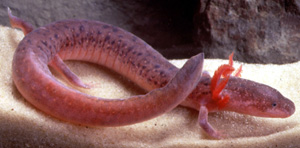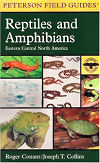
HOME
INTRO
SYMBOLS
ALMANAC
ECONOMY
GEOGRAPHY
STATE MAPS
PEOPLE
FORUM
NEWS
COOL SCHOOLS
STATE QUIZ
STATE LINKS
BOOK STORE
MARKETPLACE
GUESTBOOK
CONTACT US


Tweet
Double click on word for definition.
Tennessee State Amphibian
In February 1995, a bill was introduced to name the Tennessee Cave Salamander (Gyrinophilus palleucus) the official state amphibian of Tennessee and the Eastern Box Turtle (Terrapene carolina) the official state reptile of Tennessee. These measures were supported by the Tennessee Conference on Herpetology whose "members worked hard to pass a bill naming the Tennessee Cave Salamander as our official State Amphibian, and the Eastern Box Turtle as our official State Reptile."
House Bill 1244 was approved by the Tennessee House of Representatives on March 23, 1995 by a vote of 83-3. It was approved by the Senate on May 18, 1995 by a vote of 28-2. The legislation was signed by the Speaker of the House on May 22 and the Speaker of the Senate on May 24. It was signed by Governor Don Sundquist on May 30, 1995 with an effective date of June 12, 1995.
About the Tennessee Cave Salamander

Tennessee State Amphibian: Tennessee Cave Salamander
This large (4" - 8 7/8" long), cave-dwelling salamander has three red external gills, a broad, flat head with small, lidless eyes and a tail fin. Its snout is broad and turned-up at the tip. It's color ranges from nearly white to dark brown with spots.
It is most often found in limestone caves that contain streams in central and southeast Tennessee, parts of Alabama and Georgia. Its full range is not well known.
Currently listed as threatened by the Tennessee Wildlife Resources Agency (TWRA), the Tennessee Cave Salamander may be considered for federal status under the U.S. Endangered Species Act.
Tennessee Law
The following information was excerpted from the Tennessee Code, Title 4, Chapter 1, Part 3.
TITLE 4. STATE GOVERNMENT.
CHAPTER 1. GENERAL PROVISIONS.
PART 3. STATE SYMBOLS.
SECTION 4.1.320. STATE AMPHIBIAN.
4-1-320. State amphibian. The unique Tennessee cave salamander (Gyrinophilus palleucus) is hereby designated as the official state amphibian.
[Acts 1995, ch. 367, § 1.]
Sources...
The Tennessee Code. 2003. 3 February 2005
The Tennessee Blue Book Online 2001-2002. 2003. 3 February 2003
The Center for North American Herpetology. 2003. 3 February 2003
The Tennessee Herpetological Society. 2003. 3 February 2003
Shearer, Benjamin F. and Barbara S. State Names, Seals, Flags and Symbols: A Historical Guide Third Edition, Revised and Expanded. Westport, Conn: Greenwood Press, 3 Sub edition, 2001.
Additional Information
Tennessee Cave Salamander: Tennessee Wildlife Resources Agency.
Species Profile: Tennessee Cave Salamander (Gyrinophilus palleucus): The Cave Bio-Blog of Matthew Niemiller, evolutionary ecologist and cave biologist who studies the evolutionary biology, ecology and conservation of subterranean organisms.
Gyrinophilus palleucus Tennessee Cave Salamander, Big Mouth Cave Salamander, Pale Salamander: University of California, Berkley: AmphibiWeb.
Big Mouth Cave Salamander Gyrinophilus palleucus: The Encyclopedia of Life.
Gyrinophilus palleucus - McCrady, 1954: NatureServe Explorer.
Gyrinophilus palleucus McCrady, 1954: Integrated Taxonomic Information System (ITIS) Here you will find authoritative taxonomic information on plants, animals, fungi, and microbes of North America and the world.
State amphibians: Complete list of official state amphibians from NETSTATE.COM.
More symbols & emblems: Complete list of official Tennessee state symbols from NETSTATE.COM.
Newts and Salamandersby Frank Indiviglio
Salamanders of the United States and Canada: by James W. Petranka. 587 pages. Smithsonian; 1 edition (July 17, 1998) This survey of North American salamanders is the first since the 1940s and presents the most up-to-date research on every species. Beginning with two keys to help the reader identify an animal in the hand, whether it is an adult or a larva ("tadpole"), the book then discusses each species individually.
Newts and Salamanders: Everything About Selection, Care, Nutrition, Diseases, Breeding, and Behavior by Frank Indiviglio. 96 pages. Barron's Educational Series (June 1, 1997) Terrarium enthusiasts will find up-to-date information and full-color photos describing the major native and exotic species of newts and salamanders. The author gives advice on feeding and keeping them in a healthful environment. Topics include creating the various types of habitats, nutrition, reproduction, the treatment of diseases, and sources of food and supplies.
What is an Amphibian? (The Science of Living Things) , by Bobbie Kalman and Jacqueline Langille, 32 pages, Crabtree Publishing Company (2000). Reading level: Ages 9-12. The large, full-color photographs and illustrations that pepper every page of these books will catch the eye of browsers but it is the informative, easy-to-read texts that will hold their interest.
Peterson First Guide to Reptiles and Amphibians , by Robert C. Stebbins, Joseph T. Collins and Roger Conant. Edited by Roger Tory Peterson. 128 pages, Houghton Mifflin Harcourt (April 15, 1999). From mudpuppies to rattlesnakes, this fascinating guide for young nature lovers describes the habits and habitats of these secretive and sometimes bizarre animals, and includes tips on how to catch and care for frogs, snakes, turtles, lizards, salamanders, and toads.

A Field Guide to Reptiles & Amphibians of Eastern & Central North America, by Roger Conant and Joseph T. Collins, 640 pages, Houghton Mifflin Harcourt; Fourth Edition edition (May 15, 1998). This newly designed field guides features detailed descriptions of 595 species and subspecies. The 656 full-color illustrations and 384 drawings show key details for accurate identification. More than 100 color photographs and 333 color photographs and 333 color distribution maps accompany the species descriptions.
Firefly Encyclopedia of Reptiles and Amphibians, edited by Tim Halliday and Kraig Adler, 240 pages, Firefly Books (September 7, 2002). With lush color photographs and lavishly detailed illustrations, this encyclopedia presents a striking abundance of information at a glance. Also noteworthy is the scholarly text, a comprehensive overview of these frequently studied phyla.
Reptiles & Amphibians for Dummies, by Patricia Bartlett, 360 pages, For Dummies; 1st edition (June 1, 2003) This essential guide tells you what you must know before you own a reptile or amphibian, with authoritative advice on everything from proper caging and feeding to health care, socializing, transporting, and more. You'll find out about the different species, normal and abnormal behavior, the basics of breeding, and complying with laws.

